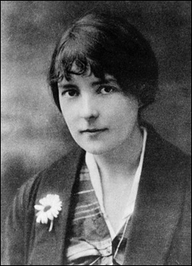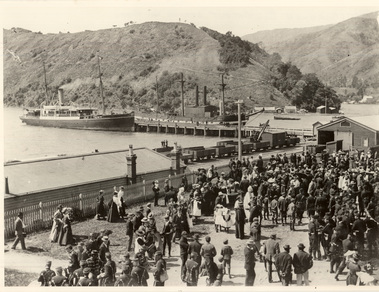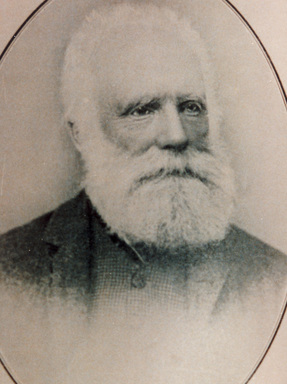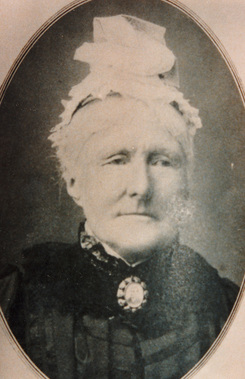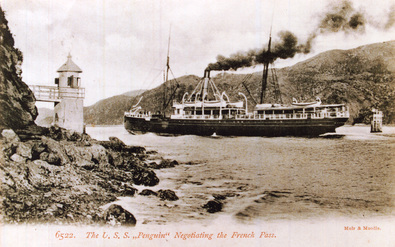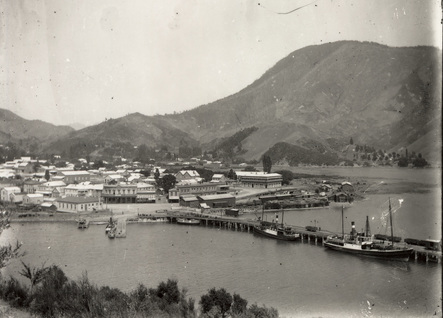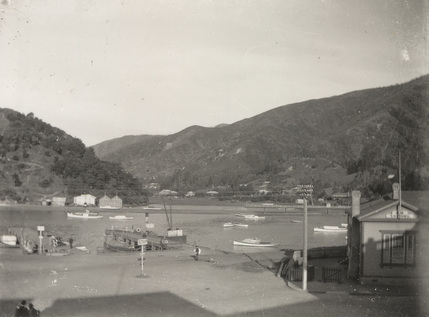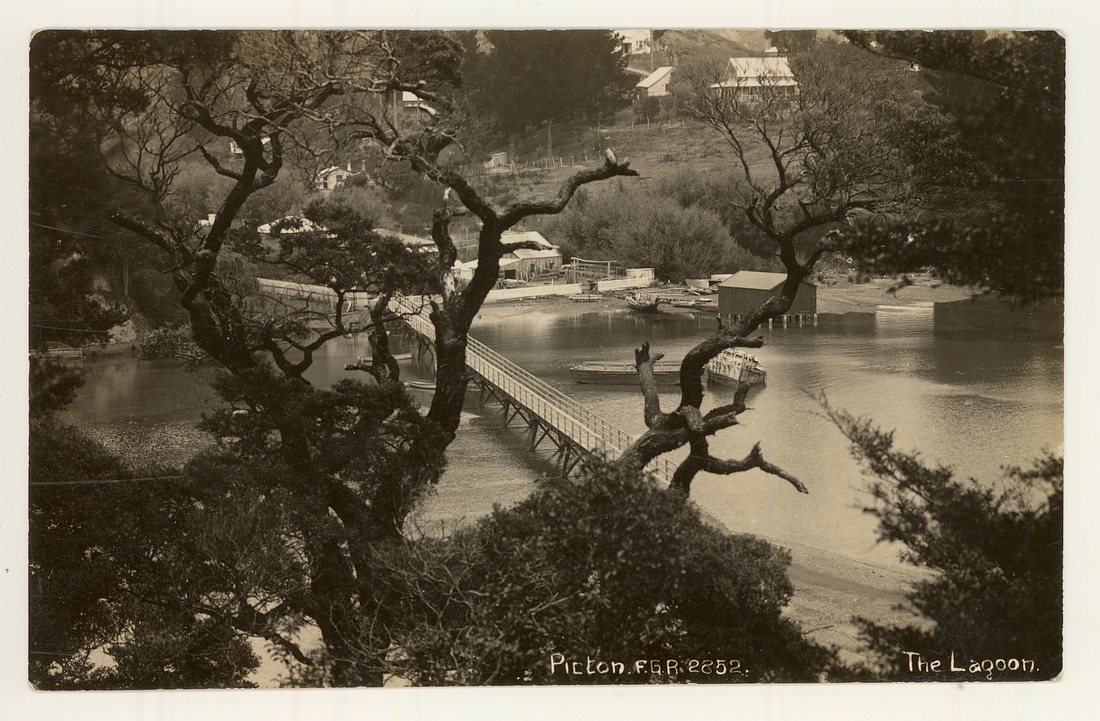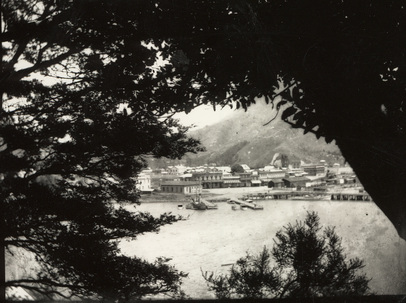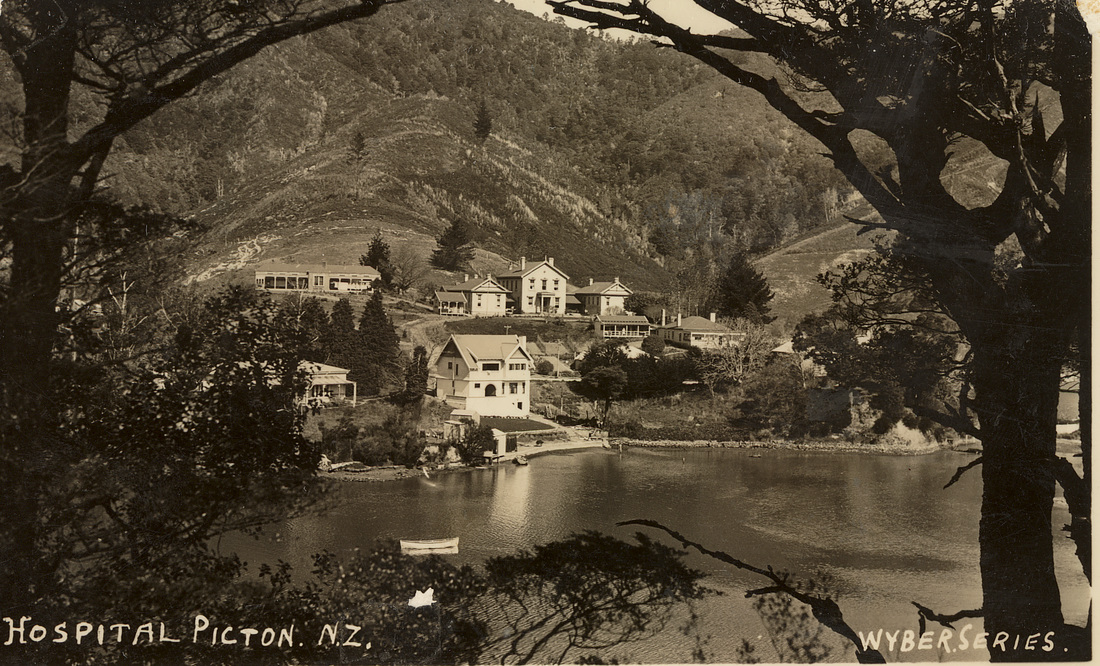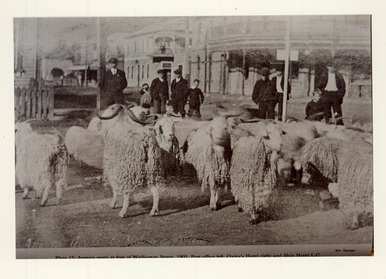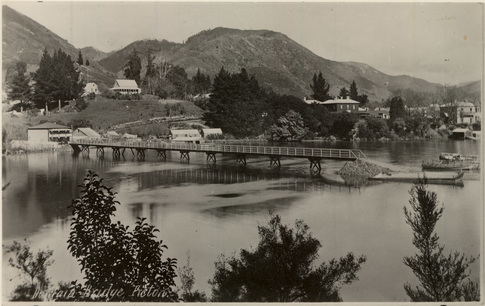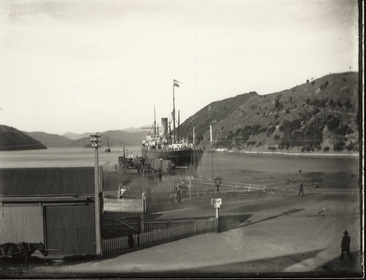Walk Picton with the Katherine Mansfield walk and Historical Information
|
If her words were set before us unknown and unplaced I think that we would lift our noses like dogs to the wind and smell our country. I think we would know the Picton boat and morning at the bay.
Poet Eileen Duggan writing on Katherine Mansfield, Selected Poems, Victoria University Press, 1994, p.128. Begin at the old Town Wharves at the eastern end of the Picton Foreshore (near all the boat operators’ offices)
Katherine Mansfield was born Kathleen Mansfield Beauchamp in Wellington and became known world wide under her assumed name of Katherine Mansfield. She is recognised as New Zealand’s most famous short story writer. Born on 14 October 1888 in Wellington, she left New Zealand on 6 July 1908, and died in France on 9 January, 1923 of a tubercular haemorrage. She was only 34 years old. |
During the years 1889-1908, the young Katherine Mansfield came many times with her family to Picton to visit her Beauchamp relatives in the South Island. These visits provided material for some of her stories. In the story, ‘The Voyage’ Fenella and her grandmother arrive on the overnight ferry from Wellington.
"Now they could see the landing-stage and some little houses, pale too, clustered together like shells on the lid of a box.
Wellington Street
This is the street that Fenella and her grandmother went up in the horse and trap probably to a house in Waikawa Road. At that time the street was not sealed.
Mr Penreddy was waiting for them on the wharf with his cart and a ‘drooping’ horse. The sun was not up, it was cold and there was a mist.
"The gangway was lowered. Again Fenella followed her grandma on to the wharf over to the little cart, and a moment later they were bowling away. The hooves of the little horse drummed over the wooden piles, then sank softly into the sandy road. Not a soul was to be seen: there was not even a feather of smoke. The mist rose and fell, and the sea still sounded asleep as slowly it turned on the beach."
"Now they could see the landing-stage and some little houses, pale too, clustered together like shells on the lid of a box.
Wellington Street
This is the street that Fenella and her grandmother went up in the horse and trap probably to a house in Waikawa Road. At that time the street was not sealed.
Mr Penreddy was waiting for them on the wharf with his cart and a ‘drooping’ horse. The sun was not up, it was cold and there was a mist.
"The gangway was lowered. Again Fenella followed her grandma on to the wharf over to the little cart, and a moment later they were bowling away. The hooves of the little horse drummed over the wooden piles, then sank softly into the sandy road. Not a soul was to be seen: there was not even a feather of smoke. The mist rose and fell, and the sea still sounded asleep as slowly it turned on the beach."
|
This is a very historic route because Wellington Street from the 1860s was the main street with the wharves, Post Office and a number of hotels. By 1900 Picton was a colourful place, with tall ships at the wharf with cargoes including exotic produce such as bananas and on New Year’s Day a boating regatta was held by Mabel Island, with hundreds coming by boat from Wellington for an annual excursion day. |
Photo 5133 Tutanekai - Picton Museum
|
Katherine Mansfield’s grandparents Arthur and Mary Beauchamp arrived in Picton in 1861 with two children one of whom was Harold Beauchamp aged three. Harold would later become Katherine Mansfield’s father. The boat they arrived on the Lalla Rookh had come from Melbourne, Australia via Wellington and would have docked at the old wharf where we are now. The Beauchamps lived in a number of houses in Picton. In 1907 Arthur and Mary were living in a house in Waikawa Road on the site of the Picton Superette. They are also known to have owned a property in Kent Street at some point and Mary Beauchamp died at the home of a relative (Bessie Greensill), in Kent Street. We do not know exactly which house is referred to in ‘The Voyage’. It is likely it is a composite of a number of houses including the second Beauchamp homestead at Anakiwa. (This house fell into disrepair in the 1960s and is no longer in existence).
"And now the little horse pulled up before one of the shell-like houses…Up a little path of round white pebbles they went, with drenched sleeping flowers on either side..."
"And now the little horse pulled up before one of the shell-like houses…Up a little path of round white pebbles they went, with drenched sleeping flowers on either side..."
Photo 032 Arthur Beauchamp and 033 Mary Beauchamp - Picton Museum
][Note: Pebble path not a shell path. Breakwater at Shelly Beach to create a new town marina constructed in 2001. Otherwise Picton Harbour looks much the same as when Katherine Mansfield was visiting. Some changes to vegetation cover on the hills.]
Katherine Mansfield was only six months old when she was brought to Picton for the first time in 1889. In a letter to John Middleton Murry, who became her husband, she refers to ‘premier voyage age de six mois’. The Beauchamp children came to Picton in the care of their maternal grandmother, Grannie Dyer, (their mother Annie Beauchamp’s mother) who lived with them. It seems that Grannie Dyer brought the children to Picton for the Easter holiday.
In the context of the story ‘The Voyage’ it is the paternal grandmother Harold Beauchamp’s mother, Mary Beauchamp, who goes to Wellington to collect Fenella after the death of her mother. Note: Katherine Mansfield’s mother died in Wellington in 1918.
The Beauchamp family regularly holidayed in Picton and the Marlborough Sounds. Sir Harold as a child spent holidays at Anakiwa and the family would also have gone to Anakiwa to visit Cradock and Harriet Beauchamp, Katherine Mansfield’s great aunt and great uncle who lived at Anakiwa for 40 years where they had a farm.
In October 1921 Katherine Mansfield wrote to her sister Jeanne, thanking her for a birthday present, and sent her a copy of the London Mercury which contained the story ‘At the Bay’.
"If we are ever together down the Kenepuru Sounds come off with me for a whole day - will you? And let’s just remember. How Chummie loved it too. Can’t you hear his soft boyish laugh and the way he said ‘oh – absolutely!"
Katherine Mansfield was only six months old when she was brought to Picton for the first time in 1889. In a letter to John Middleton Murry, who became her husband, she refers to ‘premier voyage age de six mois’. The Beauchamp children came to Picton in the care of their maternal grandmother, Grannie Dyer, (their mother Annie Beauchamp’s mother) who lived with them. It seems that Grannie Dyer brought the children to Picton for the Easter holiday.
In the context of the story ‘The Voyage’ it is the paternal grandmother Harold Beauchamp’s mother, Mary Beauchamp, who goes to Wellington to collect Fenella after the death of her mother. Note: Katherine Mansfield’s mother died in Wellington in 1918.
The Beauchamp family regularly holidayed in Picton and the Marlborough Sounds. Sir Harold as a child spent holidays at Anakiwa and the family would also have gone to Anakiwa to visit Cradock and Harriet Beauchamp, Katherine Mansfield’s great aunt and great uncle who lived at Anakiwa for 40 years where they had a farm.
In October 1921 Katherine Mansfield wrote to her sister Jeanne, thanking her for a birthday present, and sent her a copy of the London Mercury which contained the story ‘At the Bay’.
"If we are ever together down the Kenepuru Sounds come off with me for a whole day - will you? And let’s just remember. How Chummie loved it too. Can’t you hear his soft boyish laugh and the way he said ‘oh – absolutely!"
|
The Beauchamp family often made the crossing to Picton on the steamship the SS Penguin. On 12 February 1909 the Penguin struck a rock (Maybe Thoms Rock or the floating remains of a wreck) off the Wellington coast of Cook Strait and foundered with the loss of 75 lives. Katherine Mansfield left New Zealand in July 1908 so it is possible to speculate that if the Beauchamp family had been on the boat New Zealand might have lost its best known writer. She would certainly have been upset about this incident when she heard about it in England.
|
The Penguin - Photo Credit Picton Museum
|
As stated Katherine Mansfield left New Zealand in July 1908 and never returned. Years later in Switzerland she drew on her memory of ‘the little fishing village of Picton and its surrounding Sounds’ for the story ‘The Voyage’, written in 1921, and set in Picton. ‘The story evokes her own feelings as a child when making the voyage to Picton – although the child in the story is called 'Fenella’ and Arthur Beauchamp is referred to by Mr Penreddy as ‘Mr Crane’ and as ‘Walter’ by his wife.
Oxley’s Hotel façade
Oxley’s Hotel on the corner of London Quay and Wellington Street was established in 1870. The verandah and lacework drew much attention from visitors to the town. The verandah at one point was dismantled and stored and has now been refurbished and re-attached. There was an earthquake in 1959 in Picton and a number of owners/landlords were given 20 years to upgrade their buildings to comply with regulations.
Oxley’s began as the Pier Hotel and later after extensive alterations and a change of owner the name Oxley’s was added in 1909. It was the first building in Picton to have its own electric power plant. It was operated by water driven by a Pelton wheel.
In 1909 Katherine Mansfield’s brother Leslie (Chummie), and her two sisters visit their grandparents who are living in Waikawa Road and stay at Oxley’s Hotel on the waterfront in Picton. Leslie is not impressed with the hotel and feels they have eaten rather too many scones during the visit. They keep an illustrated journal during the trip which includes Nelson and send this to Katherine Mansfield in England. Arthur Beauchamp, their grandfather, is in bed when they visit and this may have provided Katherine Mansfield with the idea for the ending of the story, ‘The Voyage’ written in 1921. Interestingly Mr Penreddy in ‘The Voyage’ talking to the grandmother about her husband says that his wife had ‘knocked him up a batch of scones last week’. The grandmother in the story is named ‘Mary’ so it is likely that she has been for a visit to Wellington leaving ‘Walter’ [Arthur Beauchamp] to look after himself.
Oxley’s Hotel on the corner of London Quay and Wellington Street was established in 1870. The verandah and lacework drew much attention from visitors to the town. The verandah at one point was dismantled and stored and has now been refurbished and re-attached. There was an earthquake in 1959 in Picton and a number of owners/landlords were given 20 years to upgrade their buildings to comply with regulations.
Oxley’s began as the Pier Hotel and later after extensive alterations and a change of owner the name Oxley’s was added in 1909. It was the first building in Picton to have its own electric power plant. It was operated by water driven by a Pelton wheel.
In 1909 Katherine Mansfield’s brother Leslie (Chummie), and her two sisters visit their grandparents who are living in Waikawa Road and stay at Oxley’s Hotel on the waterfront in Picton. Leslie is not impressed with the hotel and feels they have eaten rather too many scones during the visit. They keep an illustrated journal during the trip which includes Nelson and send this to Katherine Mansfield in England. Arthur Beauchamp, their grandfather, is in bed when they visit and this may have provided Katherine Mansfield with the idea for the ending of the story, ‘The Voyage’ written in 1921. Interestingly Mr Penreddy in ‘The Voyage’ talking to the grandmother about her husband says that his wife had ‘knocked him up a batch of scones last week’. The grandmother in the story is named ‘Mary’ so it is likely that she has been for a visit to Wellington leaving ‘Walter’ [Arthur Beauchamp] to look after himself.
Old Post Office and Kiosk sites:
In 1861 there was a customhouse and Post office on the site. The new Post office was built in 1864. The Post Office moved to new premises in Mariners Mall near the top of High Street in May 1990. The old building was demolished in November 1991.
The Post Office Hotel became the Ship Hotel and burnt down in1930s. (There is a story about holidaymakers in High Street waking to hear bottles exploding in the bar).
The Kiosk (opposite side of road) Harriet Beauchamp, Katherine Mansfield’s great aunt who lived at Anakiwa, used to come up to Picton and have morning/afternoon tea at the Kiosk. She would apparently pin up her long black skirt to prevent it being creased, causing amusement to local children.
Continue on to the boutique hotel, Escape to Picton, and stop by the right of way between the two buildings. [The hotel was previously called the Settlers’ Arms and before that the 5th Bank restaurant, built 1902.]
This is approximately the site where Arthur Beauchamp, Katherine Mansfield’s grandfather began business in 1861 as a general merchant, stock salesman and auctioneer.
As stated previously he arrived in Picton in 1861 with his wife Mary and two children, one of whom was Harold, (Katherine Mansfield’s father, later Sir Harold Beauchamp), aged three.
Arthur Beauchamp’s store
1861 Arthur Beauchamp began in Wellington Street in partnership with William Welford.
1867 Arthur Beauchamp sold his share of the business
1869 William Welford recorded as having a store in Wellington Street
1889 Thomas Philpotts purchased the business. He built a concrete store for the grocer’s business. (Philpotts was headmaster of Picton School 1861-1865)
? The business then passed to Miles and D McCormick. Miles had the drapery part of the business; the other part was a general store and hardware & grocery.
[Note: As High as the Hills, p.71, mentions Seymour purchasing the business but this is incorrect.]
1915 E G Berry took over the business. (Picton Museum has the manuka hook used in E G Berry’s business to get things off shelves.)
1941 E G Berry’s son Ted Berry took over. It nearly burnt down at some stage.
1958: The business moved to High Street.
About 1963: The store in Wellington Street was demolished.
1967: The business in High Street was sold to Lindsay Rowlands.
In 1861 there was a customhouse and Post office on the site. The new Post office was built in 1864. The Post Office moved to new premises in Mariners Mall near the top of High Street in May 1990. The old building was demolished in November 1991.
The Post Office Hotel became the Ship Hotel and burnt down in1930s. (There is a story about holidaymakers in High Street waking to hear bottles exploding in the bar).
The Kiosk (opposite side of road) Harriet Beauchamp, Katherine Mansfield’s great aunt who lived at Anakiwa, used to come up to Picton and have morning/afternoon tea at the Kiosk. She would apparently pin up her long black skirt to prevent it being creased, causing amusement to local children.
Continue on to the boutique hotel, Escape to Picton, and stop by the right of way between the two buildings. [The hotel was previously called the Settlers’ Arms and before that the 5th Bank restaurant, built 1902.]
This is approximately the site where Arthur Beauchamp, Katherine Mansfield’s grandfather began business in 1861 as a general merchant, stock salesman and auctioneer.
As stated previously he arrived in Picton in 1861 with his wife Mary and two children, one of whom was Harold, (Katherine Mansfield’s father, later Sir Harold Beauchamp), aged three.
Arthur Beauchamp’s store
1861 Arthur Beauchamp began in Wellington Street in partnership with William Welford.
1867 Arthur Beauchamp sold his share of the business
1869 William Welford recorded as having a store in Wellington Street
1889 Thomas Philpotts purchased the business. He built a concrete store for the grocer’s business. (Philpotts was headmaster of Picton School 1861-1865)
? The business then passed to Miles and D McCormick. Miles had the drapery part of the business; the other part was a general store and hardware & grocery.
[Note: As High as the Hills, p.71, mentions Seymour purchasing the business but this is incorrect.]
1915 E G Berry took over the business. (Picton Museum has the manuka hook used in E G Berry’s business to get things off shelves.)
1941 E G Berry’s son Ted Berry took over. It nearly burnt down at some stage.
1958: The business moved to High Street.
About 1963: The store in Wellington Street was demolished.
1967: The business in High Street was sold to Lindsay Rowlands.
Bank of New Zealand
The boutique Hotel, Escape to Picton, was formerly the Bank of New Zealand building. The Picton branch first opened for business in 1862, from a room in the Provincial Council buildings at the top of High Street (where the police station is today). It was the fifth Bank of New Zealand branch to be opened in the country and the second in the South Island (first was in Nelson). The opening of the Picton branch took place only three months after the Bank of New Zealand was initially established in New Zealand at Auckland on 16 October 1861. (The first manager was Mr John Bridges.)
The bank moved to High Street, and later to Wellington Street. In 1902 new Wellington Street premises were built, the same wooden two-storeyed structure that stands today. For many years the restaurant was called the Fifth Bank in recognition of this past history then it became the Settlers’ Arms and now Escape to Picton as mentioned. The vault of the first occupants is still in the building and the safe is now in the Picton Museum. [The building nearly burnt down in 1998 after a fire in the bar area.]
Gold was discovered at Wakamarina in 1864 bringing prosperity to Picton as 3000 diggers passed through on their way to the goldfields. The scales used by the BNZ to weigh the gold are in the Picton Museum.
Note re Sir Harold Beauchamp (in relation to the Picton BNZ):
(Knighted in 1923)
Harold Beauchamp was appointed to the board of the Bank of New Zealand in 1898 by the Liberal Prime Minister, Richard John Seddon, who was a personal friend. He became chairman in 1907, and it is this appointment that may have led to the mistaken belief that Katherine Mansfield’s father was once manager of the bank’s Picton branch.
**Continue up Wellington Street to Broadway. Turn right. On the left hand side of the road is the Picton Police Station.
A plaque on the building commemorates early history:
On 1 November 1859, Picton became the first capital of Marlborough province. Government Buildings were opened here on 1 April 1861. From 1865, Blenheim was the capital.
In 1859 before the Beauchamps arrived, Marlborough split from Nelson Province and Picton became the first capital of Marlborough Province. Before 1860 Marlborough was part of Nelson Province (six provinces).
Arthur Beauchamp: Contribution to Politics
Arthur Beauchamp was elected to Marlborough Provincial Council as representative for Picton in Sept 1864. Before 1860 Marlborough was part of Nelson Province (six provinces). 1859 Marlborough split from Nelson and Picton became the capital of Marlborough.
In 1865 Arthur Penrose Seymour was superintendent of the Marlborough Provincial Council. Arthur Beauchamp and other party members were facing jealousy and resentment from a Blenheim faction led by William Henry Eyes. It got to the point where the two groups were meeting separately and taking separate minutes.
Arthur Beauchamp is remembered for his filibuster speech of 10 hours and 40 minutes in protest against the transfer of government from Picton to Blenheim but it failed to stop the moving of the seat of government to Blenheim. At the end of his speech he said:
‘Mr Speaker, having made these few preliminary remarks, I will now proceed to speak on the subject under discussion’.
Arthur then collapsed and had to be carried out
Three months later the Governor called for new elections. William Eyes became superintendent. The Picton party walked out in disgust. All the Marlborough Provincial Council furniture, books, papers and the town clock were taken from Picton to Blenheim by Bullock wagons. From March 1866 to June 1867 Arthur Beauchamp was member of the House of Representatives for Picton and the Marlborough Sounds travelling to Wellington for parliamentary business. In 1871 Arthur Penrose Seymour (A P Seymour), purchased a sundial to replace the town clock which had been removed to Blenheim along with all the furniture. This sundial was placed in the grounds of Holy Trinity Church on Wairau Road in 1872. It remains there today near the Church entrance. The Picton Provincial Council building burnt down in 1877.
Arthur Beauchamp's character
[A comparison could be made here of Katherine Mansfield inheriting Arthur Beauchamp’s genes – a wanderer. He was also known for his witty repartee.]
Arthur Beauchamp was an opportunist, always looking for a chance to make money. He moved to the West Coast, to Beatrix Bay in the Pelorus Sound where a son Charles Stanley was born. He went to Wanganui as the land wars were ending. Arthur was involved with sawmilling at Manaroa in the Kenepuru (at one time with Godsiff). He bought land in the Kenepuru Sound at Crail Bay, Nopera (bought a farm with his two youngest sons, Harry and Stanley – Stanley continued to farm at Nopera until 1907. Katherine Mansfield may have visited (see Kenepuru quote), and later at St Omer. He went to the far north of New Zealand but he always came back to Picton. If he had lived now, I think he would have been into mussel farming in the Marlborough Sounds and possibly also growing sauvignon blanc grapes in Marlborough.
His wife, Mary Beauchamp, was often left behind with the family while Arthur went off to establish himself in a new venture and then was ‘sent for’. Apparently she was a great letter writer.
The boutique Hotel, Escape to Picton, was formerly the Bank of New Zealand building. The Picton branch first opened for business in 1862, from a room in the Provincial Council buildings at the top of High Street (where the police station is today). It was the fifth Bank of New Zealand branch to be opened in the country and the second in the South Island (first was in Nelson). The opening of the Picton branch took place only three months after the Bank of New Zealand was initially established in New Zealand at Auckland on 16 October 1861. (The first manager was Mr John Bridges.)
The bank moved to High Street, and later to Wellington Street. In 1902 new Wellington Street premises were built, the same wooden two-storeyed structure that stands today. For many years the restaurant was called the Fifth Bank in recognition of this past history then it became the Settlers’ Arms and now Escape to Picton as mentioned. The vault of the first occupants is still in the building and the safe is now in the Picton Museum. [The building nearly burnt down in 1998 after a fire in the bar area.]
Gold was discovered at Wakamarina in 1864 bringing prosperity to Picton as 3000 diggers passed through on their way to the goldfields. The scales used by the BNZ to weigh the gold are in the Picton Museum.
Note re Sir Harold Beauchamp (in relation to the Picton BNZ):
(Knighted in 1923)
Harold Beauchamp was appointed to the board of the Bank of New Zealand in 1898 by the Liberal Prime Minister, Richard John Seddon, who was a personal friend. He became chairman in 1907, and it is this appointment that may have led to the mistaken belief that Katherine Mansfield’s father was once manager of the bank’s Picton branch.
**Continue up Wellington Street to Broadway. Turn right. On the left hand side of the road is the Picton Police Station.
A plaque on the building commemorates early history:
On 1 November 1859, Picton became the first capital of Marlborough province. Government Buildings were opened here on 1 April 1861. From 1865, Blenheim was the capital.
In 1859 before the Beauchamps arrived, Marlborough split from Nelson Province and Picton became the first capital of Marlborough Province. Before 1860 Marlborough was part of Nelson Province (six provinces).
Arthur Beauchamp: Contribution to Politics
Arthur Beauchamp was elected to Marlborough Provincial Council as representative for Picton in Sept 1864. Before 1860 Marlborough was part of Nelson Province (six provinces). 1859 Marlborough split from Nelson and Picton became the capital of Marlborough.
In 1865 Arthur Penrose Seymour was superintendent of the Marlborough Provincial Council. Arthur Beauchamp and other party members were facing jealousy and resentment from a Blenheim faction led by William Henry Eyes. It got to the point where the two groups were meeting separately and taking separate minutes.
Arthur Beauchamp is remembered for his filibuster speech of 10 hours and 40 minutes in protest against the transfer of government from Picton to Blenheim but it failed to stop the moving of the seat of government to Blenheim. At the end of his speech he said:
‘Mr Speaker, having made these few preliminary remarks, I will now proceed to speak on the subject under discussion’.
Arthur then collapsed and had to be carried out
Three months later the Governor called for new elections. William Eyes became superintendent. The Picton party walked out in disgust. All the Marlborough Provincial Council furniture, books, papers and the town clock were taken from Picton to Blenheim by Bullock wagons. From March 1866 to June 1867 Arthur Beauchamp was member of the House of Representatives for Picton and the Marlborough Sounds travelling to Wellington for parliamentary business. In 1871 Arthur Penrose Seymour (A P Seymour), purchased a sundial to replace the town clock which had been removed to Blenheim along with all the furniture. This sundial was placed in the grounds of Holy Trinity Church on Wairau Road in 1872. It remains there today near the Church entrance. The Picton Provincial Council building burnt down in 1877.
Arthur Beauchamp's character
[A comparison could be made here of Katherine Mansfield inheriting Arthur Beauchamp’s genes – a wanderer. He was also known for his witty repartee.]
Arthur Beauchamp was an opportunist, always looking for a chance to make money. He moved to the West Coast, to Beatrix Bay in the Pelorus Sound where a son Charles Stanley was born. He went to Wanganui as the land wars were ending. Arthur was involved with sawmilling at Manaroa in the Kenepuru (at one time with Godsiff). He bought land in the Kenepuru Sound at Crail Bay, Nopera (bought a farm with his two youngest sons, Harry and Stanley – Stanley continued to farm at Nopera until 1907. Katherine Mansfield may have visited (see Kenepuru quote), and later at St Omer. He went to the far north of New Zealand but he always came back to Picton. If he had lived now, I think he would have been into mussel farming in the Marlborough Sounds and possibly also growing sauvignon blanc grapes in Marlborough.
His wife, Mary Beauchamp, was often left behind with the family while Arthur went off to establish himself in a new venture and then was ‘sent for’. Apparently she was a great letter writer.
Return to Wellington Street, turn right and walk up to cross over Otago Street.
On the left hand side of the road is the site of ‘Fernhill’, the first home in Picton of Katherine Mansfield’s grandparents. Katherine Mansfield’s father, Sir Harold Beauchamp, (born 1858 in Australia), lived in this house with his parents and attended Picton School. The house was on a fine section and Arthur and Mary did much entertaining, including giving balls. (His son Arthur de Charms remembers the day when his father was elected member of the House of Representatives for Picton and the Marlborough Sounds in March 1866; ‘the Maoris from Waikawa gave an exhibition of war dances and haka on the lawn in front of the house’ - Fernhill.) The house was demolished in 1919 and another house was built (on a different site?) reusing the joinery. This second house was also called ‘Fernhill’. Today there is no indication of this past history.
Backtrack and walk down Wellington Street to Waikawa Road. Turn right and walk until you reach Marina Cove Retirement Village, (53 Waikawa Road). At the far side of Marina Cove is Rutland Street extension. Take the steps down to the marina edge.
Brooklyn
Katherine Mansfield was a visitor at ‘Brooklyn’, the Picton home of J A R Greensill and his family on Waikawa Road. He was four times Mayor of Picton. The property was developed in 1953 by the Christchurch Methodist Central Mission, and became a rest home, Wesley House. This was demolished in 1992, and the site then became part of Marina Cove, a retirement village.
‘Brooklyn’ was set in an acre of ground with a tennis court. At the bottom of the lawn, there was a salt water swimming pool, fenced off in the sea, and a boat shed. There was an orchard with a mulberry tree, peach trees, black and red currants, raspberries and gooseberries. A box hedge protected a garden border, and there were several large trees’.
In her autobiography, The Misty Isle (Mabel Island), John Greensill’s daughter Nina Barrer, recorded that many visitors came for afternoon tea or to play tennis, including the Anakiwa Beauchamps, (Cradock and Harriet and family, who were related to the Beauchamp’s by marriage). She noted that:
Among these, when visiting her grandmother, of Picton, was Kathleen Beauchamp, later Katherine Mansfield.
Fernhill (Waikawa Road) originally in Otago Street was demolished by John Hazelwood, a Picton chemist and also a draughtsman. He designed another house reusing the cedar framed French doors and the windows and called it ‘Fernhill’. His fiancée was Ethel Beauchamp (later Ethel Beauchamp Hazelwood) and she was Katherine Mansfield’s cousin with writing ambitions of her own. When she won a prize, she said in her memoirs that ‘I think the family was slightly impressed but Kathleen’s shadow darkened their orthodox lives’. John and Ethel married in 1919 and in the 1920s she started the guest house at Anakiwa known then as the Anakiwa Homestead. John Hazelwood used to walk from Picton to the Grove on a Friday after work, then row across to Anakiwa in a dinghy he kept at the Grove. In 1962 the Anakiwa Homestead building became part of the Outward Bound School.
St John in the Wilderness Church
Nina Barrer also recalls how Katherine would sometimes go with her father, John Greensill, to the little Koromiko church, St John in the Wilderness, on a Sunday:
Katherine was quite attached to my father, and was sometimes chosen to drive with him when he was filling the function of lay reader at the Sunday afternoon service ‘ out the road’ at Koromiko.
St John in the Wilderness is beside State Highway 1, between Blenheim and Picton. The church was consecrated on 4 April 1871, by Bishop Suter, and renovated for the centennial in 1971. It is still used for services and it still looks the same as when Katherine Mansfield saw it. It has a NZ Heritage Places Trust listing recorded on a plaque on a boulder in front of the church.
Sir Paul Reeves, once governor general of New Zealand and now deceased was baptised/christened in the church and apparently a swarm of bees flew through the church during the ceremony. The baptismal font is a huge clam shell.
Head back towards Picton. A short distance from Marina Cove turn right at the walkway sign, (down a flight of steps). This takes you along a path in front of private houses to the Picton Marina.
Waitohi House
When they visited Picton the Beauchamps sometimes stayed at a boarding house, Waitohi House. This was at the bottom of Taranaki Street approximately on the site of the Beachcomber Inn. The house had a commanding view of Picton Harbour and the Picton Lagoon. See newspaper clipping in Katherine Mansfield’s New Zealand, by Vincent O’Sullivan, revised edition, Steele Roberts, 2013.
The Waitohi Domain area beyond the marina was once a lagoon, the setting for one of Janet Frame’s stories, ‘The Lagoon’. The Victoria Domain Bridge was opened in 1907 and demolished around 1965 when dredging of the lagoon began and construction of the existing Coathanger Bridge. Older Picton residents like Ann Collison and Ethel Reader recall walking over the bridge to go swimming at Shelly Beach (and presumably Katherine Mansfield and her sisters). The Beauchamps may even have come over to Picton from Wellington to be present at the opening as it would have been quite an occasion.
On the left hand side of the road is the site of ‘Fernhill’, the first home in Picton of Katherine Mansfield’s grandparents. Katherine Mansfield’s father, Sir Harold Beauchamp, (born 1858 in Australia), lived in this house with his parents and attended Picton School. The house was on a fine section and Arthur and Mary did much entertaining, including giving balls. (His son Arthur de Charms remembers the day when his father was elected member of the House of Representatives for Picton and the Marlborough Sounds in March 1866; ‘the Maoris from Waikawa gave an exhibition of war dances and haka on the lawn in front of the house’ - Fernhill.) The house was demolished in 1919 and another house was built (on a different site?) reusing the joinery. This second house was also called ‘Fernhill’. Today there is no indication of this past history.
Backtrack and walk down Wellington Street to Waikawa Road. Turn right and walk until you reach Marina Cove Retirement Village, (53 Waikawa Road). At the far side of Marina Cove is Rutland Street extension. Take the steps down to the marina edge.
Brooklyn
Katherine Mansfield was a visitor at ‘Brooklyn’, the Picton home of J A R Greensill and his family on Waikawa Road. He was four times Mayor of Picton. The property was developed in 1953 by the Christchurch Methodist Central Mission, and became a rest home, Wesley House. This was demolished in 1992, and the site then became part of Marina Cove, a retirement village.
‘Brooklyn’ was set in an acre of ground with a tennis court. At the bottom of the lawn, there was a salt water swimming pool, fenced off in the sea, and a boat shed. There was an orchard with a mulberry tree, peach trees, black and red currants, raspberries and gooseberries. A box hedge protected a garden border, and there were several large trees’.
In her autobiography, The Misty Isle (Mabel Island), John Greensill’s daughter Nina Barrer, recorded that many visitors came for afternoon tea or to play tennis, including the Anakiwa Beauchamps, (Cradock and Harriet and family, who were related to the Beauchamp’s by marriage). She noted that:
Among these, when visiting her grandmother, of Picton, was Kathleen Beauchamp, later Katherine Mansfield.
Fernhill (Waikawa Road) originally in Otago Street was demolished by John Hazelwood, a Picton chemist and also a draughtsman. He designed another house reusing the cedar framed French doors and the windows and called it ‘Fernhill’. His fiancée was Ethel Beauchamp (later Ethel Beauchamp Hazelwood) and she was Katherine Mansfield’s cousin with writing ambitions of her own. When she won a prize, she said in her memoirs that ‘I think the family was slightly impressed but Kathleen’s shadow darkened their orthodox lives’. John and Ethel married in 1919 and in the 1920s she started the guest house at Anakiwa known then as the Anakiwa Homestead. John Hazelwood used to walk from Picton to the Grove on a Friday after work, then row across to Anakiwa in a dinghy he kept at the Grove. In 1962 the Anakiwa Homestead building became part of the Outward Bound School.
St John in the Wilderness Church
Nina Barrer also recalls how Katherine would sometimes go with her father, John Greensill, to the little Koromiko church, St John in the Wilderness, on a Sunday:
Katherine was quite attached to my father, and was sometimes chosen to drive with him when he was filling the function of lay reader at the Sunday afternoon service ‘ out the road’ at Koromiko.
St John in the Wilderness is beside State Highway 1, between Blenheim and Picton. The church was consecrated on 4 April 1871, by Bishop Suter, and renovated for the centennial in 1971. It is still used for services and it still looks the same as when Katherine Mansfield saw it. It has a NZ Heritage Places Trust listing recorded on a plaque on a boulder in front of the church.
Sir Paul Reeves, once governor general of New Zealand and now deceased was baptised/christened in the church and apparently a swarm of bees flew through the church during the ceremony. The baptismal font is a huge clam shell.
Head back towards Picton. A short distance from Marina Cove turn right at the walkway sign, (down a flight of steps). This takes you along a path in front of private houses to the Picton Marina.
Waitohi House
When they visited Picton the Beauchamps sometimes stayed at a boarding house, Waitohi House. This was at the bottom of Taranaki Street approximately on the site of the Beachcomber Inn. The house had a commanding view of Picton Harbour and the Picton Lagoon. See newspaper clipping in Katherine Mansfield’s New Zealand, by Vincent O’Sullivan, revised edition, Steele Roberts, 2013.
The Waitohi Domain area beyond the marina was once a lagoon, the setting for one of Janet Frame’s stories, ‘The Lagoon’. The Victoria Domain Bridge was opened in 1907 and demolished around 1965 when dredging of the lagoon began and construction of the existing Coathanger Bridge. Older Picton residents like Ann Collison and Ethel Reader recall walking over the bridge to go swimming at Shelly Beach (and presumably Katherine Mansfield and her sisters). The Beauchamps may even have come over to Picton from Wellington to be present at the opening as it would have been quite an occasion.
Janet Frame connection:
One of Janet Frame’s sisters was drowned in Picton Harbour while the family was on holiday here. Her great grandfather, John Godfrey is buried in the Picton Cemetery in a family plot quite near Arthur and Mary Beauchamp and Cradock and Harriet (inscription only) and Gus (Ethel Beauchamp Hazelwood’s brother. Ethel moved to Nile Street in Nelson in later life and is buried in Nelson).
Janet’s mother, Lottie (born Godfrey, a long-established family in Picton, Blenheim and the Wairau), went to a Picton School, and left, early, to become a dental nurse in Picton. She was a housemaid to the Picton Beauchamps, and also worked at the Anakiwa guesthouse. Janet Frame recalled in her autobiography: …we were haunted by her tales of the Guards, the Heberleys, Dieffenbach, shipwrecks in the Sounds, life in Waikawa Road and down the Maori pah …[To the is-land]
Janet Frame’s story, ‘The Lagoon’, appeared in The Lagoon and Other Stories.
Walk along past the Coathanger Bridge and back to the Picton Foreshore
The foreshore has changed radically. The Picton to Blenheim railway line used to run along the foreshore from the old wharf (construction began in1873), and there were workshops on the foreshore. In 1874 an engine shed, goods shed and passenger station were built and the remains of the old railway platform can still be seen and the 1873 penny-in-the-slot toilets.
A new railway station was built on reclaimed land on the west side of the foreshore in 1914. In 1921 the large palms were planted, (presented by Mr Gordon Maitland). This was at a time when Katherine Mansfield was in Menton, in France, probably admiring the palms there. In 1923 the area was renamed ‘Seymour Gardens’ after the death of one of Picton’s prominent politicians, Arthur Penrose Seymour. He is buried in Picton Cemetery. At some time in the 1970s the sign was removed and it became known as the Picton Foreshore. Several trees with heritage listing and plaques are in the area on the west side past the museum and there are also heritage gates.
Memorial steps
The Picton War Memorial was built to commemorate those who died in the First World War etc add details from walk.
Katherine Mansfield’s loved brother Lesley, (Chummie), was killed in Flanders, France in WW1 while demonstrating a hand grenade. The Alexander Turnbull Library acquired a trunk (2001?) containing treasured items belonging to Katherine Mansfield. One item was the telegram notifying Katherine Mansfield of her brother’s death and a photo of his grave with moss apparently gathered from it. There were also letters, photographs and a tress of Katherine Mansfield’s chestnut hair.
Continue on to the Picton Museum.
Under the museum are two tripots used in the whaling industry. A whaling extension is planned which has Resource Consent.
Inside the Picton Museum on the wall are photographs of Arthur and Mary Beauchamp and the house, ‘Brooklyn’, and some other items relevant to the Beauchamp family mentioned above. The collection includes diaries kept by Ethel Beauchamp Hazelwood at Anakiwa.
Places of interest that require transport:
Other heritage items of interest (not directly related to Katherine Mansfield)
Edwin Fox, an historic ship
© Julie Kennedy Walk notes revised in 2013 for 125th anniversary of Katherine Mansfield’s birth. See also Katherine Mansfield in Picton, Cape Catley, 2000, republished in 2016 by the author and available to purchase on this website.
Photo credits to Picton Historical Society.
One of Janet Frame’s sisters was drowned in Picton Harbour while the family was on holiday here. Her great grandfather, John Godfrey is buried in the Picton Cemetery in a family plot quite near Arthur and Mary Beauchamp and Cradock and Harriet (inscription only) and Gus (Ethel Beauchamp Hazelwood’s brother. Ethel moved to Nile Street in Nelson in later life and is buried in Nelson).
Janet’s mother, Lottie (born Godfrey, a long-established family in Picton, Blenheim and the Wairau), went to a Picton School, and left, early, to become a dental nurse in Picton. She was a housemaid to the Picton Beauchamps, and also worked at the Anakiwa guesthouse. Janet Frame recalled in her autobiography: …we were haunted by her tales of the Guards, the Heberleys, Dieffenbach, shipwrecks in the Sounds, life in Waikawa Road and down the Maori pah …[To the is-land]
Janet Frame’s story, ‘The Lagoon’, appeared in The Lagoon and Other Stories.
Walk along past the Coathanger Bridge and back to the Picton Foreshore
The foreshore has changed radically. The Picton to Blenheim railway line used to run along the foreshore from the old wharf (construction began in1873), and there were workshops on the foreshore. In 1874 an engine shed, goods shed and passenger station were built and the remains of the old railway platform can still be seen and the 1873 penny-in-the-slot toilets.
A new railway station was built on reclaimed land on the west side of the foreshore in 1914. In 1921 the large palms were planted, (presented by Mr Gordon Maitland). This was at a time when Katherine Mansfield was in Menton, in France, probably admiring the palms there. In 1923 the area was renamed ‘Seymour Gardens’ after the death of one of Picton’s prominent politicians, Arthur Penrose Seymour. He is buried in Picton Cemetery. At some time in the 1970s the sign was removed and it became known as the Picton Foreshore. Several trees with heritage listing and plaques are in the area on the west side past the museum and there are also heritage gates.
Memorial steps
The Picton War Memorial was built to commemorate those who died in the First World War etc add details from walk.
Katherine Mansfield’s loved brother Lesley, (Chummie), was killed in Flanders, France in WW1 while demonstrating a hand grenade. The Alexander Turnbull Library acquired a trunk (2001?) containing treasured items belonging to Katherine Mansfield. One item was the telegram notifying Katherine Mansfield of her brother’s death and a photo of his grave with moss apparently gathered from it. There were also letters, photographs and a tress of Katherine Mansfield’s chestnut hair.
Continue on to the Picton Museum.
Under the museum are two tripots used in the whaling industry. A whaling extension is planned which has Resource Consent.
Inside the Picton Museum on the wall are photographs of Arthur and Mary Beauchamp and the house, ‘Brooklyn’, and some other items relevant to the Beauchamp family mentioned above. The collection includes diaries kept by Ethel Beauchamp Hazelwood at Anakiwa.
Places of interest that require transport:
- St John in the Wilderness, Anglican Church at Koromiko
- Picton Cemetery
- Grove Arm Wharf
- Anakiwa, Outward Bound School (Note: there are two plaques on a circular pathway in front of the watch houses: Risk, risk anything, and Katherine Mansfield, 1888-1923).
- Kenepuru Sound, St Omer, Nopera. (See reference in one of Katherine Mansfield’s letters to Kenepuru Sound)
- Pelorus Sound, Clova Bay, Manaroa, Beatrix Bay (associated with Arthur and Mary and Sir Harold Beauchamp)
Other heritage items of interest (not directly related to Katherine Mansfield)
Edwin Fox, an historic ship
© Julie Kennedy Walk notes revised in 2013 for 125th anniversary of Katherine Mansfield’s birth. See also Katherine Mansfield in Picton, Cape Catley, 2000, republished in 2016 by the author and available to purchase on this website.
Photo credits to Picton Historical Society.
Download copy of the walk
| katherinemansfieldwalkpicton.pdf | |
| File Size: | 295 kb |
| File Type: | |
